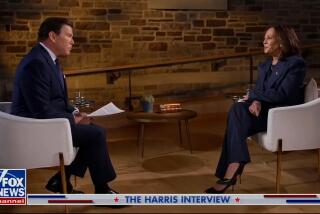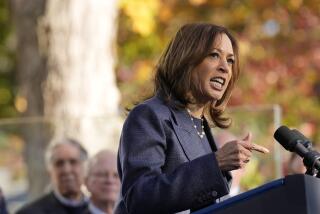Call-In Shows Question Tempo of Political Beat
WASHINGTON — The newest turn in presidential politics--the rediscovery of the viewer call-in show--is revealing stark differences between the questions reporters ask of politicians and those that voters seem interested in.
Over the course of the last two weeks, Democrat Bill Clinton and independent Ross Perot have spent several hours taking viewer questions on the “Today” show, “Larry King Live” and a CBS “National Town Hall.” Of roughly 100 questions asked, almost all focused on where the candidates stand on issues and policy. Unlike reporters on many interview shows, few viewers inquired into anyone’s personal life, poll standings or attacks from opponents.
The differences are raising provocative issues about the media and the election. Are these call-in formats, which for now have taken center stage in the campaign, just “slow-pitch softball” that allows politicians to evade unpleasantries and twist the truth, as the Washington Post suggested this week? Or does the disparity between what voters and journalists ask suggest that the media are out of touch with what voters consider important?
A comparison of broadcast interviews--those conducted by prominent journalists and those involving the public--finds troubling conclusions for both the media and the call-in format:
--A good many of the journalists’ interviews seem designed to provoke conflicts between candidates, or show up candidates as inconsistent or fuzzy on details, rather than to find out where candidates stand on issues.
--In contrast, viewers tend to stick to issues. But the call-in shows appear vulnerable to manipulation by the candidates, especially when the moderator is not aggressive about interrupting with follow-up questions.
--While viewers may be too polite to bring up the subject themselves, there is evidence that voters don’t consider personal matters irrelevant to the election.
Many in politics see the call-in shows, which were a common feature of campaigns in the 1950s and 1960s, as attempts to circumvent the press in order to get easier questions and avoid scrutiny.
“These shows are like watching rank amateur tennis players stepping onto the court with John McEnroe,” said University of Virginia professor Larry Sabato, the author of a critical review of political press coverage called “Feeding Frenzy.”
But others say the press could learn something. After listening to Clinton take questions for an hour on the “Today” show Tuesday, co-anchor Katie Couric said: “We probably should take some cues from that when we conduct our own interviews--not polls, not reactions, but basic issued-oriented questions.”
And some question whether interviews conducted by reporters are necessarily more revealing. Michael Sheehan, a consultant to Democratic candidates, says most television interviews follow a predictable, standard form. Most candidates know they will be asked three questions, Sheehan said: “Name two specific federal programs you would cut. Explain your flip-flop on the following issue. How do you deal with the following political problem or charge or scandal against you.”
Sheehan says he and other consultants usually can figure out roughly what those questions will be in advance and advise their clients to not appear evasive but to move on quickly to other subjects.
A look back at interview transcripts bear Sheehan out.
When Perot appeared on “Good Morning America” on May 22, for example, he was first asked by ABC news anchor Mike Schneider if he would declare his candidacy that morning on the air, then about polls, then about a charge that he was not being specific on issues.
In his fourth question, Schneider asked Perot to “tell me how you plan to deal with the federal deficit, how you plan to pay for national health care, how you plan to reduce the Pentagon budget.” Perot said he would need an hour to do that, although later he also said he was not prepared to do that yet in any case.
The shows sometimes push the formula to extremes, asking questions that may be fair but that “leap light-years ahead of whatever the voters are interested in,” says Sheehan. The result is a kind of political version of the TV show “American Gladiators,” he says, in which the guest contestants try to run an obstacle course while the show’s beefy cast members pummel them along the way.
On a “Meet the Press” broadcast this spring, for instance, moderator Timothy J. Russert asked Democratic presidential contender Edmund G. (Jerry) Brown Jr. what programs he would cut to reduce the deficit. When Brown said the military, Russert asked: “So how many service people would be unemployed with your cuts?”
Brown did not have an exact number. “You don’t know?” Russert accused.
Or consider a March 22 “Meet the Press” with Clinton. Russert asked: “Can you assure the Democrats across the country this morning that there is nothing in your background that might emerge which would doom your candidacy and the Democratic Party?”
Clinton, put in the position of denying something for which there was no evidence, said there was nothing that would doom him.
“How do you deal, then, with . . . the Washington Post survey the other day that 46% of the people said you didn’t have the honesty and integrity to be President?” Russert asked.
Or there was this question from NBC correspondent Andrea Mitchell: “Governor, let me explore a few examples with you of how you’ve changed your record over this campaign, which is perhaps why you’ve attracted the name over the years of ‘Slick Willie.’ ”
The conversation that ensued, while detailing Clinton’s positions, was so arcane that it was doubtful how much viewers could follow it.
The questions from viewers are much different.
In his hour on the “Today” show, for instance, Clinton took 27 viewer questions. Not one dealt with polls, asked him to respond to criticism or pursued personal or character issues.
The closest anyone came to trying to prompt a conflict was Sean from Philadelphia, who said: “I’d like to know your thoughts on Ross Perot.”
More typical was Pam from San Diego: “My question for Gov. Clinton is (what is) his position on the continuation of U.S. nuclear weapons testing.”
Some of the difference in the questions can be attributed to different interests: Voters want to know whether to vote for someone, while journalists are interested in news, which means continually finding out something new about the candidate, leading to an emphasis on controversies, changes in polls or strategy.
Journalists such as Baltimore Sun columnist Jack Germond say that “the difference clearly is the voter doesn’t have the fund of knowledge to ask detailed follow-up questions. That is why candidates like these formats, and I don’t blame them.”
But Clinton and his aides argue that the recent call-in shows provide proof that voters don’t care about all the personal and political questions reporters throw at him.
“Sure enough he goes on the ‘Today’ show for one solid hour and does not get one personal question,” said Clinton media consultant Frank Greer. “He gets only questions about what people really care about . . . it is just the opposite of what the press wants to dwell on.”
But many reporters believe it is wrong to assume that voters don’t consider such issues relevant simply because they don’t ask about them.
CNN political correspondent Ken Bode tells the story, for instance, of covering Democratic presidential candidate Gary Hart in 1987. “He constantly said the only people who ever asked him about his personal life was the press, and he was right,” Bode said. “He would go into a hall, take a half-hour of questions, and they were all about policy and issues. But afterward you would work the room with your notebook and ask people what they think, and many of them would say: ‘He is a very smart guy, but I can’t vote for him.’ ”
The lesson, Bode said, is that “people don’t ask about personal life because they are too polite to ask. But they expect us to do that for them, because that was precisely the reason they didn’t vote for him.”
The notion that most questions on the call-in shows are softballs is virtually a historical fact.
Press scholar Stephen Hess of the Brookings Institution tells the story of working on viewer call-in programs as Richard M. Nixon’s speech writer during the 1962 California governor’s race.
In those days, calls came into phone banks where volunteers wrote them on note cards for Nixon to read on the air.
“It was my job, on Nixon’s instructions, to take the cards and rewrite the questions to make them as tough as possible for Nixon to answer. And the reason for that was it made his answers more effective, more persuasive, since he thought people calling in didn’t know how to ask tough questions.”
What Nixon knew suggests that in time the candidates may find that the call-in shows will lose their effectiveness.
Germond, for one, argues that the formats are popular now because the candidates are not really engaging each other. But in the fall, when Bush and Perot and Clinton are pounding on each other, having debates and highlighting the differences between their positions, the polite nuts and bolts of these call-in programs will seem tepid to many viewers.
For now, though, even the New York Times, which several weeks ago conducted a five-hour interview with Perot, noted on its front page Friday that the two hours on “Today” was the most significant and “provided the most far-reaching” recitation of his views so far in the campaign.
RELATED STORY: A16
More to Read
Get the L.A. Times Politics newsletter
Deeply reported insights into legislation, politics and policy from Sacramento, Washington and beyond. In your inbox three times per week.
You may occasionally receive promotional content from the Los Angeles Times.










